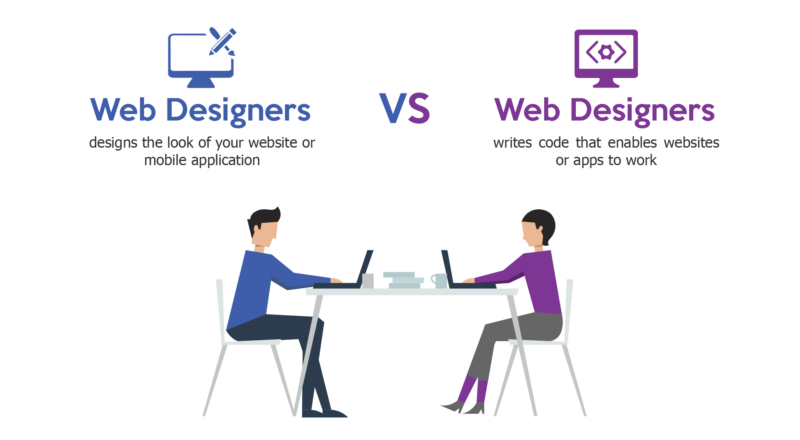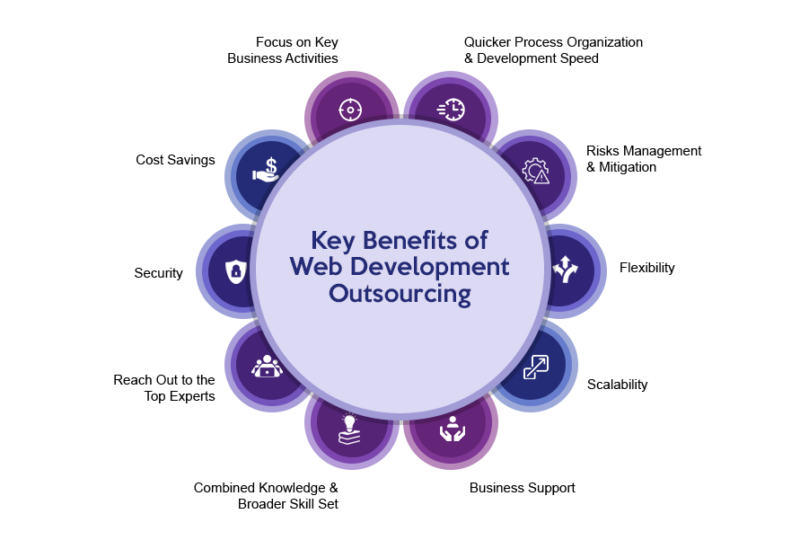The digital revolution has made it necessary for businesses to establish a robust online presence, and a crucial part of this is having a well-designed website. However, the complexities involved in web design and development can often prove challenging for businesses, especially when they lack the required in-house expertise. According to the Society for Human Resource Management, 57% of companies in 2021 used outsourcing to focus on their core business. Outsourcing web design can be an effective solution that guarantees high-quality results, offers time and cost savings, and ensures a constant up-to-date digital presence.
In this article, we will discuss what web design is, why companies should outsource web development, and break down the steps on how to outsource web design efficiently.
What Is Web Design?
Web design is a specialized discipline that focuses on the creation and design of websites. It encompasses several aspects, including web layout, content production, and graphic design. Web design is integral to web development projects, dictating a website’s aesthetic appeal and user experience.
Web design involves using various design programs to create the visual aspects of a website. Web designers play a critical role in this process, working to design engaging, intuitive layouts that align with the brand’s identity and cater to the needs of the target audience. They combine colors, fonts, images, and other visual elements to create a cohesive and visually appealing design.
However, a website is more than just its visual presentation. This is where web development services come into play. Web development takes the design created by web designers and turns it into a fully functioning website. This process involves coding and programming to ensure that all website features work as they should.

Web developers, who can be divided into two categories – front-end and back-end developers, play an essential role. Front-end developers use HTML, CSS, JavaScript, and other programming languages to bring the design files to life, focusing on the parts of the website users interact with. On the other hand, back-end developers deal with the server side of web development, ensuring that data is properly stored and retrieved as needed.
Why Should Companies Outsource Web Design

Companies should consider outsourcing web design and development for several reasons:
Expertise and Quality
Web design agencies with a professional standing bring a wealth of knowledge and experience to the table, enabling them to craft websites of high caliber that are not only aesthetically pleasing but also functional. Their grasp on modern design trends and familiarity with cutting-edge web technologies ensures your website stays at the forefront of the digital space, setting it apart from the competition. These agencies keep their skills and knowledge up-to-date, ensuring your website is created with the latest design principles and technologies, enhancing its competitive edge.
Cost-Effective
Choosing to outsource can frequently provide a more economical solution than building an in-house team, particularly for small to medium enterprises. Outsourcing mitigates various financial burdens associated with maintaining an in-house team, such as costs linked to hiring, educating new team members, and providing ongoing salaries and benefits. This cost-effective nature of outsourcing makes it an attractive strategy for businesses striving for quality work within budget constraints.
Time-Saving
Outsourcing web development services allows businesses to allocate more time to their primary operations. The selected outsourcing agency assumes responsibility for all stages of the web development process, from initial design ideation to the final testing and launching stages. This comprehensive approach frees up the company’s resources, allowing them to concentrate on their core business functions while still achieving a professionally designed and developed website.
Scalability
As your business expands, it may necessitate modifications or a complete overhaul of your website to accommodate evolving needs. This is where outsourcing agencies prove beneficial – they possess the capability to swiftly adapt and scale their services in response to your business’s growth and the subsequent changes in requirements. This flexibility ensures your website remains relevant and effective regardless of how your business needs might shift over time
Access to Latest Tools and Technologies
Outsourcing firms come equipped with state-of-the-art web design instruments and technologies. This access to the latest resources guarantees that your website is designed to be contemporary and efficient, and maintains compliance with the prevailing industry standards, providing a professional and up-to-date online presence for your business.
Ongoing Support and Maintenance
Numerous web design agencies offer sustained support and maintenance services as part of their package. This continuous assistance is crucial for addressing any technical difficulties, implementing necessary updates, and guaranteeing the prolonged efficacy of your website. Such dedicated post-launch care ensures that your website remains optimized and functional, serving your business needs effectively over time.
What’s Next? How To Outsource Web Design?
1. Identify Your Web Design Requirements
Embarking on the journey of outsourcing your web development or design starts with a crucial first step – understanding and articulating your project’s scope and specific requirements. A well-defined project blueprint is not just a roadmap for your web agency, but it also ensures that the end product effectively serves your business’s unique needs.
The process of defining your project requirements involves numerous considerations. First and foremost, you need to determine what kind of website best fits your operations and objectives:
- Are you planning to establish an e-commerce platform to sell products or services?
- Do you need a portfolio site to showcase your creative endeavors?
- Or perhaps you require an informational website to educate your audience about a specific subject or cause?
Once you have identified the type of website you need, the next step is to ascertain the necessary functionality. This could include features like a shopping cart for an e-commerce site, a contact form for a portfolio site, or an interactive map for an informational site.
Design preferences are another critical aspect to consider. Think about the aesthetic you want for your website – the color scheme, typography, layout, and any specific branding elements that should be incorporated into the design.
Next, it’s essential to identify your target audience. Knowing who will be using your website can inform your design and functionality choices, ensuring a user-friendly experience that meets their expectations and needs.
Furthermore, clear website goals should be set. These might involve driving more traffic, increasing time spent on your site, reducing bounce rates, improving conversion rates, or any other key performance indicators that align with your business objectives.
At first glance, this preparatory stage might seem rather labor-intensive and time-consuming. However, it’s a crucial part of ensuring effective outsourcing. According to a study by Deloitte, 31% of IT services are outsourced with the primary objective of enhancing service delivery. By meticulously defining your requirements at the outset, you can set a strong foundation for your outsourced web design project, which in turn aids in achieving this objective of improved service delivery.
2. Choose the Right Web Design Agency
The process of outsourcing web development services necessitates a careful and thorough selection of the right web development company. The importance of this decision cannot be overstated, as the chosen agency’s expertise and reliability will significantly impact the quality of your website.
Before settling on an agency, a comprehensive evaluation of their work is essential. One way to gauge their ability is by reviewing their portfolio. A diverse portfolio that showcases a wide range of web design styles and industries is often indicative of an agency’s versatility and expertise.
In addition to the portfolio, client testimonials can provide valuable insight into the agency’s work ethics, punctuality, communication skills, and ability to deliver as per expectations. Online reviews are another useful source of information. By reading about other clients’ experiences, you can get a sense of the agency’s strengths and weaknesses, helping you make an informed decision.
The importance of expertise when selecting web development outsourcing companies was highlighted in a 2021 study by Clutch.co, which revealed that 61% of businesses outsource specifically to tap into the skills and knowledge of experts. Thus, the agency’s expertise and proven experience should play a pivotal role in your decision-making process.
3. Establish Clear Communication Channels
For any company looking to outsource web development services, one fundamental aspect to a thriving outsourcing relationship is clear and effective communication. This requires the establishment of well-defined channels of communication to ensure that all parties are on the same page, understanding project expectations, timelines, and progress.
To ensure a smooth workflow, it’s crucial to identify specific points of contact. These individuals should be responsible for streamlining communication between your business and the web development company. Having dedicated points of contact reduces the risk of miscommunication, ensures that queries are addressed promptly, and information is conveyed accurately.
In addition to clear channels and points of contact, scheduling regular meetings for updates is equally important. These meetings provide an opportunity for all parties to discuss the project’s progress, address any concerns, clarify doubts, and make necessary adjustments. Regular interactions help keep the project on track and foster a collaborative environment.
However, maintaining strong communication is more than just beneficial – it’s essential. According to data from Statista, 28% of outsourcing failures in 2021 were attributed to inadequate communication. This statistic underscores the crucial role that effective communication plays in the success of an outsourcing relationship.
Poor communication can lead to misunderstandings, misaligned expectations, and ultimately, project failure. Therefore, investing time and resources into establishing robust communication practices with your chosen outsourcing company is paramount.
4. Secure Intellectual Property Rights
In the digital landscape, the assets you create or possess online, such as your website design, content, and even your domain name, can be as valuable as tangible property. Therefore, ensuring these are adequately protected should be a priority.
Intellectual property includes several components, such as trademarks, copyrights, patents, and trade secrets. In the context of a web project, it could pertain to the original content you publish on your site, the unique interface or features of your website, or your specific brand elements that are incorporated into the site’s design. All these components contribute to the distinct identity of your business online and should be safeguarded from unauthorized use.
To secure your intellectual property rights when outsourcing, it’s essential to include clear terms in your contract with the web development outsourcing company. These terms should define who owns what regarding the content, code, design, and other creative elements that will be part of your website. Ideally, the contract should state that your company retains the ownership of these elements, even though they were created by the outsourced agency.
The need for this protective measure is underscored by data from the World Intellectual Property Organization. According to the organization, there was a 12% increase in disputes involving domain names in 2022. This rise in conflicts highlights the importance of preemptively securing your intellectual property rights when engaging in an outsourcing partnership.
Moreover, it’s not just about the legal protection of your assets; it’s also about safeguarding the integrity of your brand. Your website is an extension of your brand identity, and any misuse or unauthorized replication of its unique elements can dilute your brand’s value and credibility. Therefore, securing your intellectual property rights is as much a strategic move as it is a legal one.
5. Review the Design and Provide Feedback
Engage actively with the web development process and design, reviewing and providing constructive feedback. According to a 2022 Forrester report, businesses that are deeply involved in their digital transformation process see a 35% better return on investment.
6. Testing and Deployment
After the design phase, ensure that the website is thoroughly tested for functionality, responsiveness, and user experience before deployment. According to a 2021 report by Capgemini, businesses that don’t thoroughly test their websites lose approximately 20% of their potential online sales.
Outsourcing web design has the potential to deliver a superior quality website while allowing you to focus on your core business operations. As a C-suite leader, it’s vital to approach this strategically to ensure the best outcomes for your business in the digital landscape.
Bottomline, the digital era continues to evolve, and businesses must adapt to maintain their competitive edge. Outsourcing website development and design is a practical, efficient, and cost-effective solution for businesses seeking to establish a strong online presence. You can effectively outsource web design and maximize your digital potential by defining your requirements, choosing the right agency, establishing clear communication, securing intellectual property rights, actively engaging in the design process, and ensuring thorough testing and deployment.
However, remember that your website is a crucial component of your business’s overall digital strategy, so constant monitoring, analysis, and updating should be maintained even after completing the design process. While outsourcing can handle the heavy lifting of web design, the responsibility of leveraging it as an effective business tool ultimately lies with you and your team.



Leave A Comment
You must be logged in to post a comment.